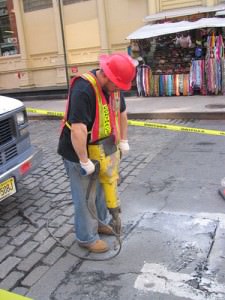 In South Korea, a purpose built city ($25B) is rising into the sky called New Songdo City, which will be around the size of Boston – and build in 10 years. This purpose built city, with it’s LEED certified green buildings and innovative architecture is designed to serve as a major centrally-located business hub between Japan and China. But New Songdo City has a problem. Getting from the new city center to the Incheon International Airport is a bitch. You must ride up to 1.5 hours in a roundabout route to cross the only existing bridge in horrible traffic – and this is BEFORE the city is finished and millions more people begin to live and worth there.
In South Korea, a purpose built city ($25B) is rising into the sky called New Songdo City, which will be around the size of Boston – and build in 10 years. This purpose built city, with it’s LEED certified green buildings and innovative architecture is designed to serve as a major centrally-located business hub between Japan and China. But New Songdo City has a problem. Getting from the new city center to the Incheon International Airport is a bitch. You must ride up to 1.5 hours in a roundabout route to cross the only existing bridge in horrible traffic – and this is BEFORE the city is finished and millions more people begin to live and worth there.
So they’re building a bridge. A big bridge spanning 7-miles of muddy-tidal-water and a busy shipping channel will link New Songdo City center and the newly renovated Incheon International Airport. With the trip between airport and business center cut in half, New Songdo City makes sense. It truly is a bridge to the future.
Anticipation of completion is palatable to everyone in South Korea from civil and structural engineers involved the CAD files to the 4 year old dreaming the paddleboats at the new Central Park. If a reminder is needed, all they do is look out over the harbor and see the gap closing. Everyone knows when traffic starts flowing, things start happening. Their commitment to the project is unwavering. Seeing visible progress, there on the harbor, is deeply satisfying to all stakeholders.
 There are powerful similarities between this and web projects. In the web design phase, clients see beautiful mock ups or pre-launch versions of the site, feeling the warmth that something is out there. At first it’s skeletal, but still, visible evidence emerges that things are moving. Eventually, gaps close. Ribbons are cut, launch parties held, Webbys distributed – a very satisfying experience.
There are powerful similarities between this and web projects. In the web design phase, clients see beautiful mock ups or pre-launch versions of the site, feeling the warmth that something is out there. At first it’s skeletal, but still, visible evidence emerges that things are moving. Eventually, gaps close. Ribbons are cut, launch parties held, Webbys distributed – a very satisfying experience.
With structural CAD work, the computer will help by warning if you’re stretching safe limits for a certain material or situation, letting you rethink ideas while they are pixels rather than iron and concrete. No such warning exists when a site is being designed. What looks good on the prototype can work poorly for users or search engines. But web design may not get such a rigorous framework to guide it or may miss things under intense pressures. Designing is often done under pressure and usability, copywriting and SEM work can take a serious back-seat getting pixels on the screen. Even the most talented designer with experience in usability and SEO can be forced into serious compromises. As a result, the search engines can drop or reduce the new site in the listings. Traffic and leads can drop to a trickle the day after launch and take months to recover.
Oh, s$#!*, here come the SEMs
We have externally acquired best practices to apply to your site and, largely due to the abstract nature, there is a natural resistance to follow recommendations. We start talking about invisible concepts such as bot hearding and page rank sculpting. We start adding work to your plate by asking your staff to create “link-worthy” content free from the usual sales language and totally unique from anything else on the web. You shift in your seat as we ask you to leverage professional relationships to get links of a very specific type inside their industry.
We debate importance of site maps and worry about problems with robots files and mess with htaccess files and x-robots tags (“whatever the hell those are”).. But even after all of that obscure activity, we ask our clients to wait for Googlebot or other web robots to pass judgment over our work. Social media marketing requirements make it even harder. We ask you to remove walls that exist between your customers and your company, deploying personal “authenticity” where “thought leaders” at your company can build “tribes” that encourage buzz amongst industry influencers. Then, we must see if the content that was developed earns links, bookmarks and buzz.
Just as with the Incheon bridge, the organic and social traffic that will flow is essential to success of your website, even if you don’t have gleaming evidence out there on the harbor, and the unwavering support of the SEM initiatives just as important.
If we arrive late in the project (80% of the time this is true) there can be issues buried beneath the design, meaning our recommendations are especially disruptive and uncomfortable to those who didn’t consider the SEO/SMM issues before so much was finished. Back to the bridge metaphor, imagine the structural engineer that recommended too little reinforcements or too much concrete on a finished section of a bridge. While diplomacy can help to smooth these situations some, SEM recommendations can feel like a thorn in the shoes of those walking beneath the gleaming new towers of a website.
In a worst case, we ask you to get out the jackhammers to remove freshly poured concrete. Executives start making calls and pressure builds to explain why the SEM guy is asking for changes. They look at Google and find that there is no ranking improvement yet. They start questioning the SEM’s importance to the overall success of the project. Some even STOP PAYING the SEM until they come up with solutions that do not require the things they recommend. Some even begin spreading dispariging information about how the consultant is unqualified. This really must stop, so here are some tips that might help.
Making It Better…Education is the Lifeblood of SEM Success
To survive this, the SEM team members must all agree that education – early and often – is essential. If your client’s executive staff are not educated about the (crazy, social and dynamic) nature of modern SEM then you can count on poor support and high levels of frustration. It doesn’t matter if the bridge reaches 1% or 99%, the project will not meet the goals, and all hell breaks loose.
If you’re involved in working with an SEM consultant or in-house SEM expert there are some things to consider.
- Give the SEM program a chance before you begin pulling resources and calling “emergency” progress meetings. Tip: 30 minutes is not enough time to “bring the boss up to speed on SEM,” but this post might come close.
- Keep the team consistently informed. Resources shift – that is a normal business reality. But if new people are introduced into your SEM project you absolutely must give them time to understand what’s going on before they call “BS” and derail the project. I have failed miserably on this before. It’s one of the worst feelings in the world.
- Keep the big picture in mind. Looking at a mid-stream SEM project can look very much like an bridge to nowhere. Help people to see the other side coming to meet them. Patience is key in SEO.
- Realize that customized SEM projects may need to change course mid-stream as your consultant learns more about the business, the competitors and your internal priorities. A-ha moments are a good thing. Do not consider that a failure in project management!
- Do not, under any circumstances, put the SEM consultant into the “I.T. bucket” in your company. This is asking for a wholesale disaster – and I speak from much experience. The SEM consultant will need I.T. resources from time to time (e.g. hosting, CRM integration, logfiles, email, project software) but SEM is not an I.T. endeavor.
- Plan, carefully and with consideration of personal ambition, the transfer of needed expertise to your staff members. Early in the project get them together for a beer to celebrate the start of the SEM initiative. Fly one to meet the other if they are in different cities. Do whatever you can to encourage a fluid, cobeneficial relationship. Is there a staff member who has SEM ambition? Make sure the consultant knows this – as most solid consultants are thrilled to help them nurture needed skills. Don’t worry about SEM’s working to “protect their job security” – as top SEMs usually have many choices of projects, even in a recession.
For the SEM, I recommend:
- Plan for new people skeptical people. Have an education webinar ready. If any new persons join the project or a new executive extends control over it, help that person to understand the SEM initiative. They can’t see the bridge yet, so it’s your job to describe it. I’m working on this webinar now for my company right now…urgently, and will be adding a clause in my agreement – “all work ends if any participant on the project has not been given the SEM basics presentation”
- Utilize tools that help with collaberation and make sure everyone uses it. I recommend basecamp or something similar. If there is one hold-out that won’t use the system, you have a major problem. Google docs rocks. Adobe buzzword rocks. Just use something!
- Forge strong, productive relationships with CIO/CTO, Web Designers, Marketing, Legal and Human Resources and Product Development. You may not interact with all of these people much, but they should not be in the dark about SEM (e.g. optimizing job listings or using special URLs on press releases, etc.)
- Create a system that identifies open loops and responsible parties. Make it easy for people to see that they have open tasks rather than badgering about it all the time. Have an esculation procedure for those not finishing tasks and for identify critical paths.
- Understand who owns the project. Sounds silly huh? It’s not! I have found out, 3 months into a retainer project that the person I was working with was not in charge of the SEM project with whom I’d never spoken. My jaw hit the floor, believe me.
- Help the team visualize the end result, but also realize that SEO is an ongoing task. Find a way that everyone can buy into that shows where you are in the project. It can be a gantt chart or a simple list, but use it consistently and daily. Show that progress is happening. When improvements occur in rank attribute them as best you can. And make sure you are laying the foundation for the internal resources to take your place before the end of the agreement.
- Know when to get out. Don’t kill your love for SEM for one client who won’t listen. It’s not worth it. There are times when nobody wants to hear what you have to say. The recommendations will be ignored. You should find an esculation path for issues and follow it, but if there is no satisfaction, close shop. And if anyone ever denies payment, take them to collections and arbituration. Please do not be bullied by clients who won’t admit they screwed up on something.
Please add your own guidelines to the comments. I’m passionate about making projects successful. But I’ve learned that technical knowledge and good SEM plans do not succeed without strong synergies between consultants and company resources.
I hope this post will help you build many productive bridges in your future SEM projects. Disagree? Agree? I look forward to your comments.
Postscript: Please check out Lee Odden’s post on Getting the most Value from SEO consultants.
Bridge photo by Ryan Wick, map photo and Jackhammer photo by Aofe both used under Creative Commons Attribution 2.0 Generic license. New Songdo regional map from Gale International’s New Songdo City site (warning, loud audio when site loads)







